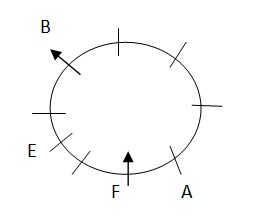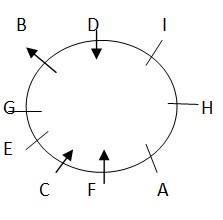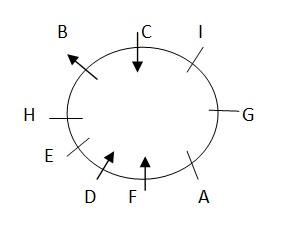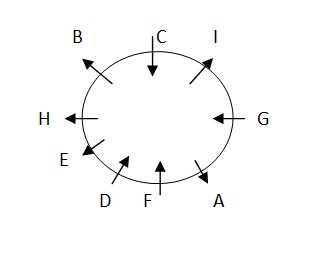E sits 2nd to the left of F, who faces towards the centre. One person sits between E and B. A sits 4th to the right of B. So, A sits immediate right of F. B faces outside.  H sits 2nd to the left of D, who faces towards the centre. G sits 2nd to the left of C, who doesn’t face same direction as B. H doesn’t sit with F. So, H sits 3rd to the right of B or immediate left of B and C sits immediate left of F or 4th to the right of F. Case I: C sits immediate left of F:
H sits 2nd to the left of D, who faces towards the centre. G sits 2nd to the left of C, who doesn’t face same direction as B. H doesn’t sit with F. So, H sits 3rd to the right of B or immediate left of B and C sits immediate left of F or 4th to the right of F. Case I: C sits immediate left of F:  Case II: C sits 4th to the right of F:
Case II: C sits 4th to the right of F:  I doesn’t sit adjacent to H, so case I is rejected. Immediate neighbors of G face opposite direction to G. So, G must face towards the centre while I and A face outside and H and E face outside. The final seating arrangement is given below:
I doesn’t sit adjacent to H, so case I is rejected. Immediate neighbors of G face opposite direction to G. So, G must face towards the centre while I and A face outside and H and E face outside. The final seating arrangement is given below: 
What is the maximum age for a member of a joint public service commission to hold his/her office as per the Constitution of India?
In the National Cooperative Development Corporation (NCDC) was established for strengthening the cooperative activities in
In potatoes, black heart is caused by:
Under Mission Antyodaya, who among the following in not eligible to enter data in Mission Antyodaya System?
Under the Prime Minister's Employment Generation Programme (PMEGP) the Khadi and Village Industries Commission(KVIC) has created how many lakh jobs in t...
Which empire/ dynasty was founded by the Harihara I and Bukka?
The Airport Authority of India(AAI) started a scheme to encourage the talent of women, artisans and craftsmen and provide them with the right ...
Where is India's first Small Animal Hospital located?
Which of the following organisms is commonly known as blue-green algae?
______________ are the oldest living tree species on Earth.